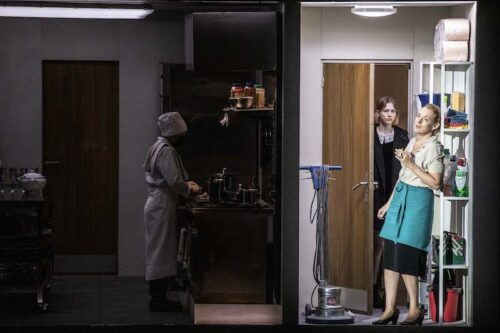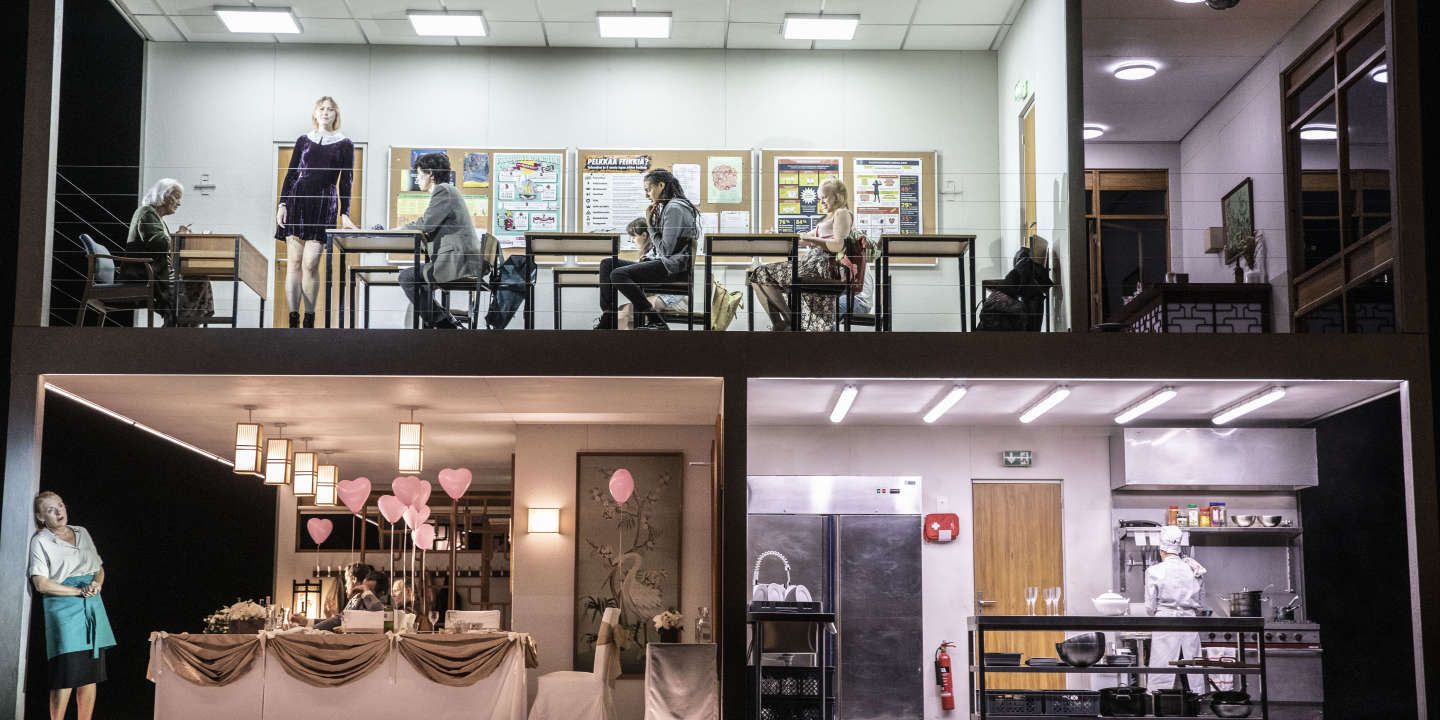 France Aix-en-Provence Festival 2021 [2] – Kaija Saariaho’s Innocence: Soloists, Estonian Philharmonic Chamber Choir, London Symphony Orchestra / Susanna Mälkki (conductor). 10.7.2021 Performance filmed (directed by Philippe Béziat) at the Grand Théâtre de Provence, Aix-en-Provence, and available on ARTE Concert until 1.7.2024. (JPr)
France Aix-en-Provence Festival 2021 [2] – Kaija Saariaho’s Innocence: Soloists, Estonian Philharmonic Chamber Choir, London Symphony Orchestra / Susanna Mälkki (conductor). 10.7.2021 Performance filmed (directed by Philippe Béziat) at the Grand Théâtre de Provence, Aix-en-Provence, and available on ARTE Concert until 1.7.2024. (JPr)

Production:
Stage director – Simon Stone
Stage designer – Chloe Lamford
Costume designer – Mel Page
Lighting designer – James Farncombe
Choreography – Arco Renz
Sound engineer – Timo Kurkikangas
Chorusmaster – Lodewijk van der Ree
Cast:
Waitress (Tereza) – Magdalena Kožená
Mother-in-law (Patricia) – Sandrine Piau
Father-in-law (Henrik) – Tuomas Pursio
Bride (Stela) – Lilian Farahani
Bridegroom (Tuomas) – Markus Nykänen
Priest – Jukka Rasilainen
Teacher – Lucy Shelton
Student 1 (Marketa) – Vilma Jää
Student 2 (Lilly) – Beate Mordal
Student 3 – Julie Hega
Student 4 – Simon Kluth
Student 5 (Jeronimo) – Camilo Delgado Díaz
Student 6 – Marina Dumont
There are going to be many commentators in future years discussing this opera and this opportunity to join those at Aix-en-Provence who were the first to see it should not be missed. When opera houses throughout the world return to whatever normal it is likely to be, Finnish composer Kaija Saariaho’s 2018 Innocence should be seen more widely courtesy of those who jointly commissioned it along with the Festival International d’Art Lyrique d’Aix-en-Provence. These are the Royal Opera House Covent Garden, Finnish National Opera, San Francisco Opera and Dutch National Opera and it was also created in partnership with the Metropolitan Opera, New York. Innocence is nominally in five acts though there is no interval and it lasts only 1 hour and 45 minutes. The original Finnish libretto was by Sofi Oksanen and the multilingual libretto version we saw and heard is by Aleksi Barrière. The main singing language is English and additional – occasionally interchangeable – languages apart from Finnish are Czech, French, German, Greek, Romanian, Spanish and Swedish.

Chloe Lamford’s two-storey – almost constantly turning – building initially has the sign CONVALLARIA which research shows can be interpreted as ‘innocence’, and this changes later to INTERNATIONAL SCHOOL where students are gathering and giving voice to their internal dialogues. Throughout the rest of Innocence, we are not always sure whether characters are addressing each other or just ‘talking’ out loud. It is twenty-first century Helsinki and in the modern fashion (particularly noticeable in recent TV dramas) the story moves back and forth from an incident ten years before to the wedding reception we are at in the present day. It is all seamlessly choreographed by Simon Stone and his collaborator Arco Renz. (Philippe Béziat’s direction for the recording places us almost continually in close-up at the heart of the story and you will never understand Innocence better than by watching it on ARTE Concert!)
On the lower floor the room where the wedding guests are dining morphs into the school before, during and after there is an attack on its staff and students. As the two strands of the plot progress the rooms empty, walls will now be bare or smeared with blood, with victims lying around: we learn ten students and one teacher were killed. (I have read that Saariaho was inspired by Leonardo da Vinci’s ‘The Last Supper’ and this was the reason for her cast of 13 soloists.) The opening is rather prosaic and – if you have not read anything about Innocence – you will wonder where the story is going. But as the backstory becomes more obvious, Innocence draws you relentlessly in. As the threads of hidden secrets, culpability, retribution and guilt, intertwine intriguingly in the experiences and recollections of the family gathered together for a (supposedly) happy event this brings out into the open all they have done so hard to put behind them.
The deus ex machina in all is this is the waitress (Tereza) who just by chance ends up serving at the dinner in the absence of a colleague. She is the mother of one of the victims of what we learn is a shooting by a young gunman at the school. It quickly dawns on her whose wedding she is helping cater and is horrified to learn that the perpetrator (the bridegroom’s brother) has recently been released from psychiatric care (he was underage at the time of the atrocity) and has begun a new life with a new name. The waitress’s daughter (Marketa) was one of his victims. The gunman-brother had not been invited to the wedding – nor is he willingly talked about – because the bridegroom (Tuomas) never wants to see him again. In fact, he is marrying Stela who he met in Romania and who grew up in an orphanage. Finland is all new to her and she has no more idea of the family’s history than what she has been told. She is unaware, of course, that her husband-to-be even had a brother.
The waitress is seething and later in the opera it becomes too much for her when she serves the wedding cake; she snaps and demands an explanation for their son’s actions from his parents, Patricia (who get covered in cake) and Henrik. Tereza’s behaviour finally makes the family face up to their past and reveal all to Stela about the tragedy that befell them a decade earlier. The Priest who seems to have his own crisis of faith to deal with suggests love forgives all. When Stela and Tuomas confront each other her reaction is rather unexpected: she explains that it was him she fell in love and not his family and she can forgive the deceit. Nevertheless, it is too much for Tuomas who leaves her now his family’s past has come back to haunt him.
Side by side with all this is the story of the teacher and six of the students involved in the shooting, at least one – possibly more – is a ghost. I was watching German subtitles and it was not always possible to follow their motivations, but it seems the students may not have all been entirely innocent themselves in what took place. The gunman-to-be looks to have suffered the taunting and bullying of his peers and although we never see anyone with a gun – they are just referred to – there was a semi-naked boy cowering in the corner of an empty room at one point and this humiliation may have been the ‘trigger’ for the later bloodbath. (Part of that being due to a mocking song sung by Marketa who he will eventually take his revenge out on.) As an ex-teacher myself I recognised only too well how jaded the teacher who is central to this arc was. We hear how she thought she wasn’t fit for her job anymore and reveals that she now finds ‘Each textbook stupid, each exam superfluous’. The teacher blames herself for not spotting how troubled her student was and later she says – quite chillingly – how ‘The first body was found behind my desk’.
[Spoiler alert] at the end we learn how Tuomas blames himself for the tragedy as he knew his brother was practicing shooting with one of his father’s guns and how he had even joined in. His elder brother was a hero to Tuomas: he craved his approval and loved him then and now. To him it was a game, but had Tuomas told someone about it, the attack on the school might have been prevented. He had kept this secret – the most tragic of all – to himself all through the intervening years.
Saariaho’s score begins as it means to go on and I immediately thought of a movie soundtrack and in its angularity and sparce scoring it was the composer Bernard Hermann I first thought of. As it goes on there are reminders of Alban Berg, Richard Strauss and Benjamin Britten amongst others. Hearing it through loudspeakers it seemed to have got the perfect advocate in Susanna Mälkki who encouraged those on stage, as well as the Estonian Philharmonic Chamber Choir and London Symphony Orchestra to surmount all the musical challenges Saariaho sets them.
The featured roles are sung or spoken depending on whether it is performed by a singer or an actor. Singing more than speaking are Sandrine Piau as Patricia who is suitably intense though she struggles with the English, and Lilian Farahani and Markus Nykänen impress as the unhappy couple Stela and Tuomas. Lucy Shelton bitingly voices her bitterness over her inaction as the teacher and Jukka Rasilainen uses a suitably world-weary Sprechstimme as the priest. Julie Hega’s student was an intriguing character who I don’t think I got to the bottom of as she seems to drift through all the trauma happening to those around her and provide something of a commentary on all we see.
Wide-eyed and increasingly distraught Magdalena Kožená (Tereza) strikingly relives all the sadness of her daughter Marketa’s murder and desperately holds on to her memories of her, so much so that she appears haunted by them. In the most amazing singing in this performance Vilma Jää (a Finnish folk musician and composer) brings eerie, piping, otherworldly, crystal-clear tones to her ghostly doll-like presence as Marketa. (Apparently her vocal histrionics are nothing less than a homage to traditional Finnish herding calls.)
The ending for Saariaho’s Innocence could have gone one of two ways: had the students we heard from been those who died they could have been recounting the lives they might have lived. I believe – though am not entirely convinced – those we do hear from are some of the survivors and so engendering optimism there are some good things we learn about what had happened to them in the following years. Nevertheless, there is still time for Marketa’s ghost to appear to Tereza telling her to stop buying her birthday presents and to finally let her go, as this engrossing, thought-provoking commentary on gun violence and much else ends.
Jim Pritchard
